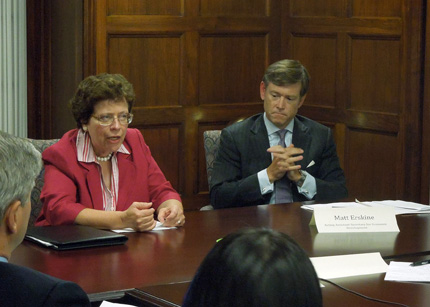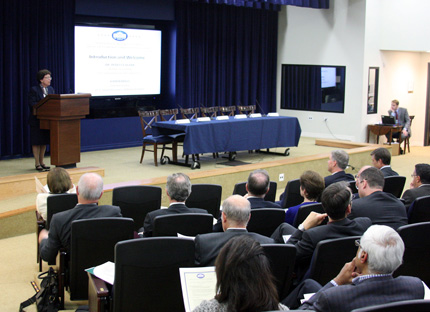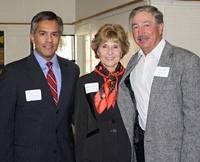
DECEMBER 2012
Q&A:Deputy Assistant Secretary Matt ErskineRegional Innovation Strategies, at the Forefront of Economic Development, Yield Results
Matt Erskine, of the Economic Development Administration (EDA), was appointed deputy assistant secretary of commerce and chief operating officer in September 2011. Before joining the Obama administration, Erskine worked in the private and public sectors, including serving as deputy secretary of the Virginia Department of Commerce and Trade. Erskine shared with us his thoughts about EDA's recent accomplishments and what he sees in store for 2013. Q:What have been EDA's most significant accomplishments over the past year? A: EDA has just closed out a fiscal year that's been more productive than ever. And in a time of tight budgets, economic challenges, and political gridlock, we were tremendously successful in fulfilling our core responsibility of partnering with our grantees to make long-term, merit-based catalytic investments that will equip America's regions to compete in the global marketplace. You can see that in the hundreds of grants we made this year under EDA's traditional development programs, which are helping communities find new engines of job creation and recover from the deepest economic downturn this country has experienced in generations. And you can see that in the important work we are doing to help eligible communities respond to and mitigate natural disasters through the $200 million that was appropriated to us by Congress to help them with long-term economic recovery and infrastructure support. EDA was also instrumental this year in the continued implementation of the challenge grant programs that are an important part of President Obama's push to create an economy that is "built to last." In partnership with several other federal agencies, in 2012 we awarded $9 million to 13 winners of the Rural Jobs and Innovation Accelerator Challenge, $7 million to the seven winners of the 2012 i6 Challenge, $1 million each to three winners of the second Strong Cities, Strong Communities (SC2) Challenge, and $6.5 million to 10 winners of the Advanced Manufacturing Jobs and Innovation Accelerator Challenge. Q:What is your vision for EDA for the next year? A: There is a continued need for leadership on strategies and programs that support the long-term economic well-being of our country. Communities and regions cannot allow their future to be determined by chance. They need to rethink how they approach economic development. Many are already defining what they are good at and identifying what existing assets they can build on and leverage, what competitive advantages they possess, and what high-growth industries will be on the horizon. EDA will continue to play a pivotal role in that process by working with communities and stakeholders to fund planning studies and analyses; facilitate partnerships between business, higher education, and government; and provide grants for infrastructure when development plans are ready to go. Our approach is working in countless places across the country. In Prince George County, Virginia, for example, a partnership between the federal government, the state government, the state's two largest four-year universities, and the local community college-together with local manufacturers-established the Commonwealth Center for Advanced Manufacturing. This center is addressing workforce and applied research issues, and it will support a new Rolls Royce facility that recently opened nearby. That new plant is manufacturing advanced components for aircraft engines, almost all of which will be exported. This is an excellent example of how a community-especially a distressed one-can leverage its strengths, bring together strategic partners, and create jobs. The economic benefits will reverberate throughout the region. Of course, over the coming year EDA will continue to invest in competitive projects under its regular quarterly funding cycle. We will also make the funding opportunity announcement for the exciting Make it in America initiative that Acting Secretary Blank announced in late September. This $40 million, multi-agency challenge will help communities that are poised to attract a major investment, but just need a little more help to get the deal done. For example, maybe a city needs a better road to an industrial site, or maybe a manufacturer looking to relocate is seeking better information and technical assistance, or maybe local workers need a tailored training program to fill a particular skills gap. This competition will provide the critical infrastructure, strategic planning, capacity building, technical assistance, and workforce development resources that will help American communities be the desired home for more businesses. Up to 15 projects will be selected through this challenge to help create an economy built to last. Q:What is EDA's biggest asset? A: That's a simple answer: EDA's biggest asset is its people, with their expertise, intimate knowledge of local conditions, and person-to-person connections throughout the country. As the only federal agency with economic development as its sole mission, EDA plays an important role in strengthening regional economies so that the United States can out-innovate, out-build, and out-compete the rest of the world. And we take on that task with a very small staff working out of our six regional offices and our headquarters here in Washington, D.C. Our people possess unique knowledge that they bring to the communities we serve. Whether they are civil engineers, construction project managers, economic development representatives, or administrative specialists-they know their stuff! And when I speak with grantees, I hear over and over again how the knowledge and expertise of EDA's staff has worked not just to the benefit of the particular project being funded, but to the economic well-being of the entire surrounding community. 
Strengthening Manufacturing at HomeAdvanced Manufacturing Projects Awarded FundingTen public-private partnerships were awarded a total of $6.5 million to help revitalize American manufacturing and encourage companies to invest in the United States. The partnerships, announced October 9, were selected through the Advanced Manufacturing Jobs and Innovation Accelerator Challenge, which is a competitive multi-agency grant process announced in May 2012 to support initiatives that strengthen advanced manufacturing at the local level. The Challenge is a partnership between EDA and the U.S. Department of Commerce’s National Institute of Standards and Technology, the U.S. Department of Energy, the U.S. Department of Labor’s Employment and Training Administration, the U.S. Small Business Administration, and the National Science Foundation. Make it in America Challenge AnnouncedIn September, Acting Secretary of Commerce Rebecca Blank announced the Make it in America Challenge, which is an initiative designed to accelerate the trend of insourcing—that is, companies bringing jobs back and making additional investments in America. The competition is being funded by EDA, the Department of Commerce’s National Institute of Standards and Technology Manufacturing Extension Partnership, and the Department of Labor’s Employment and Training Administration. It will build upon the administration’s bottom-up approach to strengthening the economy and creating jobs by partnering with state, regional, and local economies. Stay tuned for details on how to apply. Promoting American Innovation and Strengthening Entrepreneurshipi6 Challenge Winners to Jumpstart the Innovation EconomySeven winning projects-based in California, Florida, Indiana, Missouri, New Mexico, Virginia, and Wisconsin-will each receive up to $1 million to fund proof of concept centers under the latest round of the Obama administration’s i6 Challenge. The projects incorporate a range of services, such as technology and market evaluation and business planning, that are critical to regional economic growth and job creation. They will spur sustainable startups, small businesses, and new ventures. Launched in 2010 as a component of the White House’s Startup America initiative, the i6 Challenge is led by the E /DA’s Office of Innovation and Entrepreneurship.
Members of the National Advisory Council on Innovation and Entrepreneurship and representatives of institutions of higher education listen to a presentation by Acting Secretary of Commerce Rebecca Blank at the White House Conference Center on University Leaders and Obama Administration Accelerate Commercialization EffortsLeaders from numerous institutions of higher learning convened with members of the National Advisory Council on Innovation and Entrepreneurship (NACIE) on October 1 to report on the ways they are leading the charge to create new entrepreneurial ecosystems. About 300 participants renewed their commitment to innovation and entrepreneurship on their campuses and in their communities, and asked for the continued support of the federal government in improving these critical components of the American economy. Economic Recovery after DisastersHelping Communities Affected by DisasterOne of EDAs key roles following a major disaster is to help facilitate and coordinate economic recovery with communities impacted by natural disasters. When Hurricane Sandy hit the Mid-Atlantic and Northeastern states in November, EDA joined with several other federal agencies to deploy staff to help hard-hit communities throughout the region. EDA team members have been working with officials from the Federal Emergency Management Agency (FEMA), the Small Business Administration (SBA), U.S. Department of Agriculture, economic development partners, and the affected communities to identify long-term strategies that will help the communities restore their local economies, expedite recovery, and minimize economic losses. This response by EDA and other federal agencies marked the first time that the National Disaster Recovery Framework (NDRF) was implemented for a disaster of Sandys significance since it was unveiled by the Obama administration in September 2011. The NDRF is a multiagency effort designed to better coordinate federal response to work more efficiently and effectively with states and communities impacted by major disasters. It seeks to achieve this by establishing structures, defining leadership roles and responsibilities, and guiding coordination and recovery planning at all levels of government. EDA has also continued to work with communities throughout the Midwest that have been affected by the worst drought the United States has experienced in many years. In October and November, the U.S. Department of Agriculture partnered with the Department of Commerce, SBA, and FEMA to conduct a series of four regional workshops that outlined resources that are available to assist drought-stricken communities with their recovery efforts. EDA was a partner on the these important workshops, which were held in Omaha, Nebraska; Pueblo, Colorado; Pine Bluff, Arkansas, and Archbold, Ohio. The workshops provided state and local officials with information about how they can use existing programs to speed recovery efforts and develop long-term strategies for rebuilding their economies. These include such things as help with building economic recovery planning capacity, connecting with alternative sources of capital access for small-business recovery, and retaining highly skilled workers in affected regions. |
|
|
||||
In This IssuePresident Obama Tours PA Business that Benefitted from EDA Funds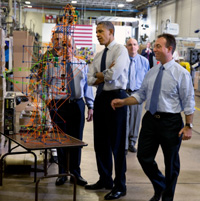
President Obama at the production facility of K'Nex toys in Hatfield, Pennsylvania, on November 30, 2012. The company benefitted from EDA-funded programs offered by the World Trade Center of Greater Philadelphia. Year-long Policy Academy Helps Eight States Support ManufacturingAdvanced manufacturing is where the future of American manufacturing lies. A year-long National Governors Association (NGA) Policy Academy, “Making Our Future: Encouraging Growth Opportunities in Manufacturing through Innovation, Entrepreneurship, and Innovation,” which was undertaken thanks to a collaboration between the NGA, EDA, National Institute of Standards and Technology, State Science and Technology Institute, and the Council for Community Economic Research just wrapped up in October. Launched in 2011, the Policy Academy offered technical support to eight states-California, Colorado, Connecticut, Illinois, Kansas, Massachusetts, New York, and Pennsylvania-that are seeking to spur local manufacturing and create jobs. The eight were selected to participate in this highly interactive, team-based program in order to help them develop plans that will improve the general environment for innovation and that will align state R&D investments, workforce development, and education systems to better serve their goals of supporting innovation and growth. Online Tool Helps Communities Rebuild Their EconomiesEDA helps provide disaster-stricken communities with access to the information and tools they need to rebuild. Recently, with EDA funding, the International Economic Development Council (IEDC), re-launched one such tool-the newly redesigned RestoreYourEconomy.org website. This is designed to be a one-stop resource for economic development organizations and chambers of commerce seeking to assist businesses after a disaster. 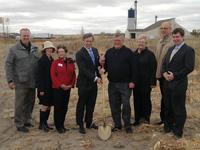
Acting Assistant Secretary of Commerce Matt Erskine joined local officials in Dawson, Minnesota, on October 4 for groundbreaking ceremonies at the Dawson Industrial Park. A $1.2 million EDA investment that was announced in September will fund critical roadway and wastewater infrastructure improvements to the industrial park that will help attract new businesses and jobs to the region. Disaster Recovery Framework ImplementedSecretary of Agriculture Tom Vilsack announced the implementation of the National Disaster Recovery Framework (NDRF) on September 3. The framework links local, state, tribal, and federal governments, the private sector and non-governmental and community organizations that play vital roles in recovery. It is a scalable, adaptable coordinating structure that helps align key roles and responsibilities in response to disaster recovery. EDA is a participant in the NDRF on behalf of the Department of Commerce in its role for the Economic Recovery Support Function. Application Package for FY 2013 Economic Development Assistance Programs Now AvailableInformation about EDA’s FY 2013 grant application process under its Public Works and Economic Adjustment Assistance programs is now available at www.grants.gov. The announcement can be found by searching for Funding Opportunity number EDAP2013. Application packages can be downloaded from Grants.gov and either submitted electronically or on paper to one of EDA’s regional offices. Detailed instructions on completing an application for funding can be found in section IV.B of the Funding Opportunity. (Applications for assistance from EDA’s other programs are governed by different funding opportunities, which are published on the agency’s website at www.eda.gov once available.)
Thomas Guevara, EDA’s deputy assistant secretary for regional affairs joined Colorado Agriculture Commissioner John Salazar and Colleen Callahan of the U.S. Department of Agriculture at a regional workshop on drought relief that was held October 15 in Pueblo, Colorado. Upcoming Economic Development Events
December 11, 2012National Advisory Council on Innovation and Entrepreneurship, Quarterly Meeting, Washington, D.C. January 17-19, 2013U.S. Conference of Mayors, Winter Forum, Washington, D.C. January 27-29, 2013IEDC Leadership Summit, Orlando, Florida |

